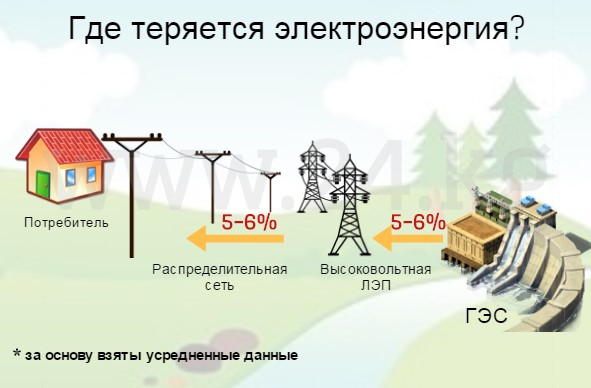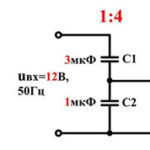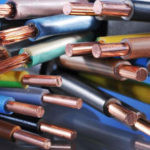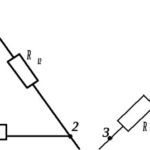When calculating the loss of electricity in a cable, it is important to take into account its length, core cross-sections, specific inductive resistance, and wire connection. Thanks to this background information, you will be able to independently calculate the voltage drop.
Content
Types and structure of losses
Even the most efficient power supply systems have some actual power loss. Losses are understood as the difference between the electric energy given to users and the fact that it came to them. This is due to the imperfection of the systems and the physical properties of the materials from which they are made.

The most common type of power loss in electrical networks is associated with voltage losses due to cable length.To normalize financial expenses and calculate their actual value, the following classification was developed:
- technical factor. It is related to the features of physical processes and can change under the influence of loads, conditional fixed costs and climatic circumstances.
- The cost of using additional supplies and providing the necessary conditions for the activities of technical personnel.
- commercial factor. This group includes deviations due to the imperfection of instrumentation and other points that provoke an underestimation of electrical energy.
The main causes of voltage loss
The main reason for the loss of power in the cable is the loss in power lines. At a distance from the power plant to consumers, not only the power of electricity is dissipated, but also the voltage drops (which, when reaching a value less than the minimum allowable value, can provoke not only inefficient operation of the devices, but also their complete inoperability.
Also, losses in electrical networks can be caused by the reactive component of a section of an electrical circuit, that is, the presence of any inductive elements in these sections (these can be communication coils and circuits, transformers, low and high frequency chokes, electric motors).
Ways to reduce losses in electrical networks
The network user cannot influence the losses in the power transmission line, but can reduce the voltage drop in the circuit section by correctly connecting its elements.
It is better to connect copper cable to copper cable, and aluminum cable to aluminum cable.It is better to minimize the number of wire connections where the core material changes, since in such places not only energy is dissipated, but also heat generation increases, which, if the level of thermal insulation is insufficient, can be a fire hazard. Given the conductivity and resistivity of copper and aluminum, it is more efficient to use copper in terms of energy costs.
If possible, when planning an electrical circuit, it is better to connect any inductive elements such as coils (L), transformers and electric motors in parallel, since according to the laws of physics, the total inductance of such a circuit decreases, and when connected in series, on the contrary, it increases.
Capacitive units (or RC filters in combination with resistors) are also used to smooth the reactive component.

Depending on the principle of connecting capacitors and the consumer, there are several types of compensation: personal, group and general.
- With personal compensation, the capacitances are connected directly to the place where reactive power appears, that is, their own capacitor - to an asynchronous motor, one more - to a gas discharge lamp, one more - to a welding one, one more - for a transformer, etc. At this point, the incoming cables are unloaded from reactive currents to the individual user.
- Group compensation involves connecting one or more capacitors to several elements with large inductive characteristics. In this situation, the regular simultaneous activity of several consumers is associated with the transfer of total reactive energy between loads and capacitors. The line that supplies electrical energy to a group of loads will unload.
- General compensation involves the insertion of capacitors with a regulator in the main switchboard, or main switchboard. It evaluates the actual consumption of reactive power and quickly connects and disconnects the required number of capacitors. As a result, the total power taken from the network is reduced to a minimum in accordance with the instantaneous value of the required reactive power.
- All reactive power compensation installations include a pair of capacitor branches, a pair of stages, which are formed specifically for the electrical network, depending on potential loads. Typical dimensions of steps: 5; ten; twenty; thirty; fifty; 7.5; 12.5; 25 sq.
To acquire large steps (100 or more kvar), small ones are connected in parallel. The loads on the network are reduced, the switching currents and their interference are reduced. In networks with many high harmonics of the mains voltage, capacitors are protected by chokes.

Automatic compensators provide the network equipped with them with the following advantages:
- reduce the load of transformers;
- make cable cross-section requirements simpler;
- make it possible to load the power grid more than possible without compensation;
- eliminate the causes of a decrease in the mains voltage, even when the load is connected by long cables;
- increase the efficiency of mobile generators on fuel;
- make it easier to start electric motors;
- increase cosine phi;
- eliminate reactive power from the circuits;
- protect against surges;
- improve network performance adjustment.
Cable voltage loss calculator
For any cable, voltage loss calculation can be done online. Below is an online voltage cable loss calculator.
The calculator is under development and will be available soon.
Formula calculation
If you want to independently calculate what the voltage drop in the wire is, given its length and other factors affecting the losses, you can use the formula for calculating the voltage drop in the cable:
ΔU, % = (Un - U) * 100 / Un,
where Un - rated voltage at the input to the network;
U is the voltage on a separate network element (the losses are calculated as a percentage of the nominal voltage present at the input).
From this, we can derive the formula for calculating energy losses:
ΔP,% = (Un - U) * I * 100 / Un,
where Un - rated voltage at the input to the network;
I is the actual network current;
U is the voltage on a separate network element (the losses are calculated as a percentage of the nominal voltage present at the input).
Table of voltage losses along the length of the cable
Below are the approximate voltage drops along the length of the cable (Knorring table). We determine the required section and look at the value in the corresponding column.
| ΔU, % | Load torque for copper conductors, kW∙m, two-wire lines for voltage 220 V | |||||
|---|---|---|---|---|---|---|
| With conductor cross section s, mm², equal to | ||||||
| 1,5 | 2,5 | 4 | 6 | 10 | 16 | |
| 1 | 18 | 30 | 48 | 72 | 120 | 192 |
| 2 | 36 | 60 | 96 | 144 | 240 | 384 |
| 3 | 54 | 90 | 144 | 216 | 360 | 576 |
| 4 | 72 | 120 | 192 | 288 | 480 | 768 |
| 5 | 90 | 150 | 240 | 360 | 600 | 960 |
Wire strands radiate heat when current flows. The size of the current, together with the resistance of the conductors, determines the degree of loss. If you have data on the resistance of the cable and the amount of current passing through them, you can find out the amount of losses in the circuit.
The tables do not take into account inductive reactance, as when using wires, it is excessively small and cannot equal active.
Who pays for electricity losses
Losses of electricity during transmission (if it is transmitted over long distances) can be significant. This affects the financial side of the issue. The reactive component is taken into account when determining the general tariff for the use of rated current for the population.
For single-phase lines, it is already included in the price, taking into account the network parameters. For legal entities, this component is calculated regardless of active loads and is indicated separately in the invoice provided, at a special rate (cheaper than active). This is done due to the presence in enterprises of a large number of induction mechanisms (for example, electric motors).
Energy supervision authorities establish the permissible voltage drop, or the standard for losses in electrical networks. The user pays for the losses during power transmission. Therefore, from the point of view of the consumer, it is economically beneficial to think about how to reduce them by changing the characteristics of the electrical circuit.
Similar articles:






